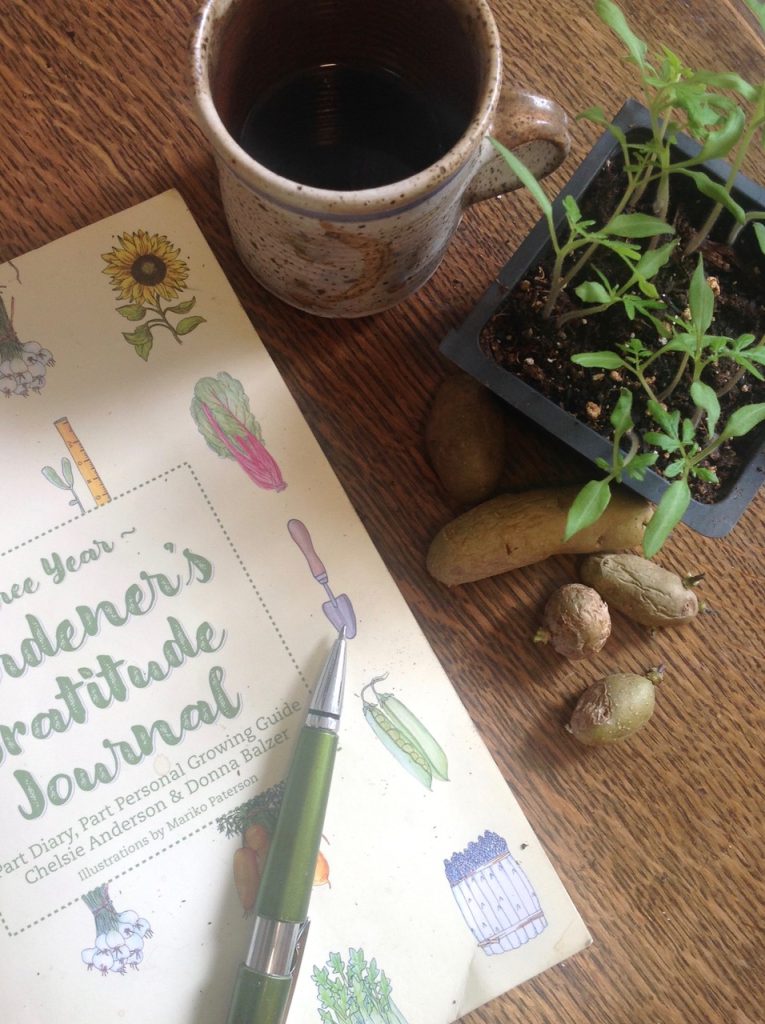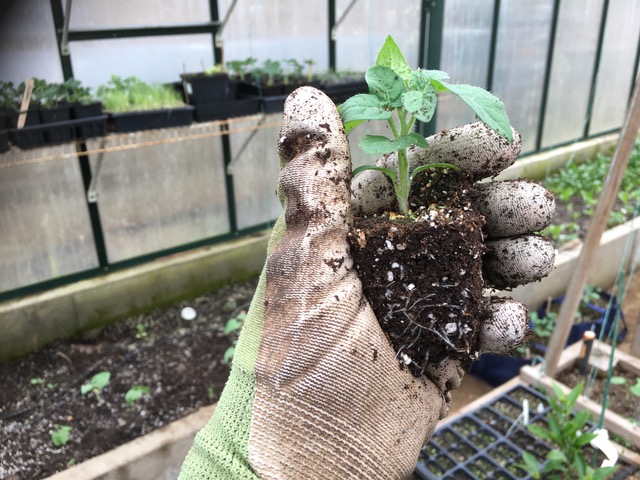A client planted her brand new greenhouse in late August this year with the goal of growing vegetables and harvesting food all winter. My 12 year-old grandson made the same plan, except he is using his dad’s back yard and doesn’t have a greenhouse. Compared to hobby greenhouse growers, my grandson’s plan to eat fresh food from his yard in our cold wintery climate is limited. He’ll be able to eat fresh all summer and dig root crops from his garden like potatoes, beets and carrots for fall dining. But winter vegetable harvest is minimal in a back yard without a greenhouse.
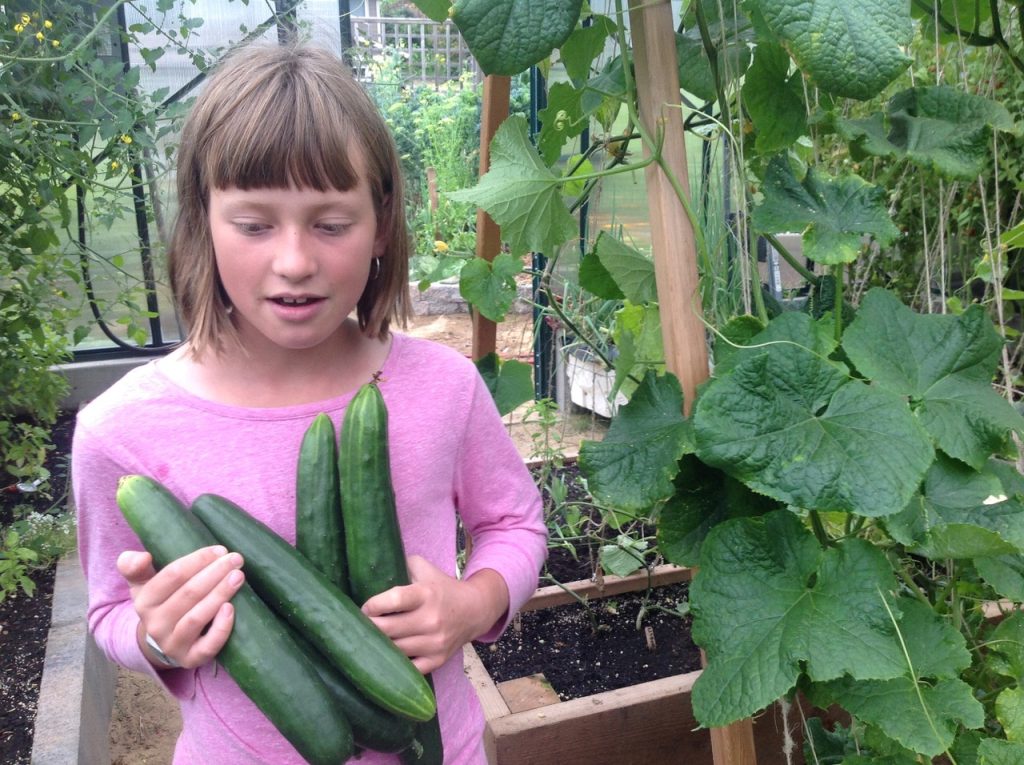
Cucumbers readily sprawl up a simple string vertical garden. Here, my grand-daughter Mali is picking cucumbers in the summer, not in the winter. Cucumber is classed as a “warm season crop” and even in a greenhouse, the climate controls needed to produce a “warm” season crop like cucumbers in winter is massive. Climate controls would have to mimic long days and warm nights. This is why you see commercial greenhouses glowing at night well past sunset and hobby greenhouses focussing on growing cold season crops.
Unless you’ve been in a closet, you’ve probably heard about food insecurity so the admirable growing goals of both my client and my grandson are reason to celebrate. But despite their optimism, northern gardeners (above the 49th parallel), have trouble growing loads of food with natural light once days are cold and short. In fact growing food any time after mid-October in Canada is a bit of a stretch, even in a greenhouse, unless you choose plants carefully and adjust your expectations.
Growing food to a harvestable size in a greenhouse requires 10 hours of light per day – for best results. “Maintaining” food in a greenhouse is different than growing food. Once a perfect size, cold weather vegetable crops will hold in a cool, even frozen, greenhouse. But getting food to harvestable size continuously all winter is tough unless you choose plants that can be partially picked, harvested for maximum space efficiency and given the space to slowly grow.
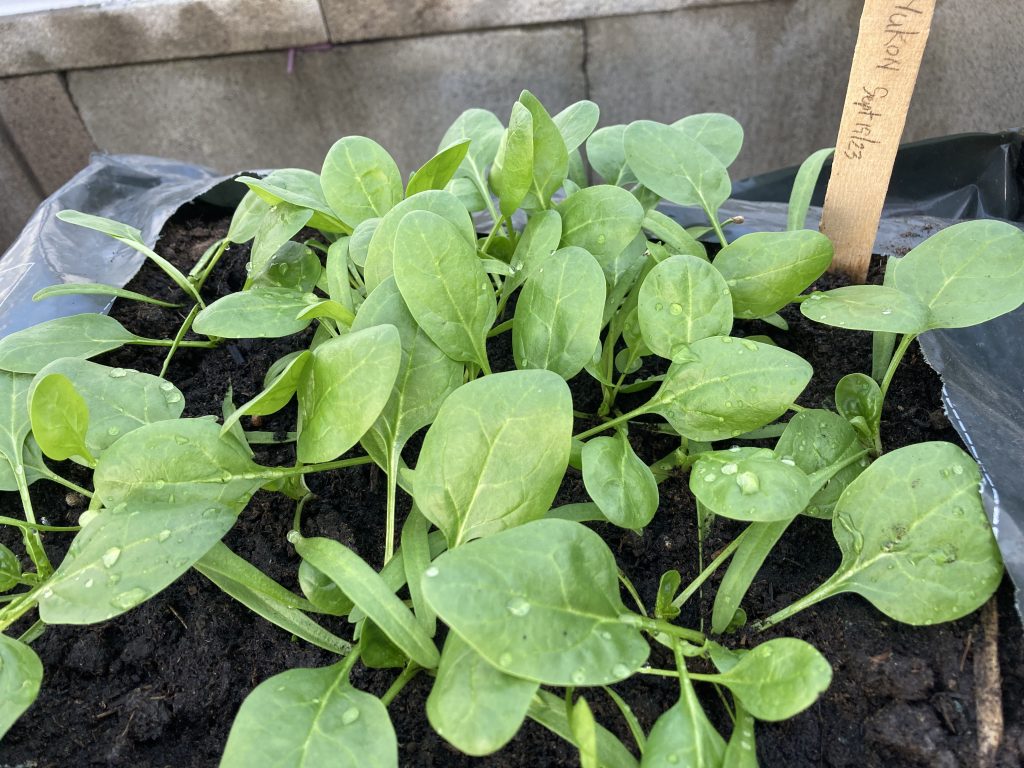
Cool season crop, Yukon Spinach, was direct-seeded in my Calgary, Alberta greenhouse on September 19 and harvested starting in late October. My high-low thermometer shows coldest temperatures inside the greenhouse as low as minus 6 degrees C so far this fall. I supply some frost protection by using a small electric heater set to a “frost protection” setting but I don’s have grow-lights inside my greenhouse and so I will only get one or two harvests of spinach this winter. I harvest leaves individually instead of pulling the whole plant out and I expect another harvest from these same plants in December. In Alberta and other northern climates, fall-seeded outdoor spinach will start growing again outside from late March to early April while greenhouse spinach will grow actively again by the end of February. In other words, the greenhouse offers an opportunity for cool winter crop harvests and a big boost in harvest length compared to outdoor crops.
GARDENING IN A GREENHOUSE: BE PATIENT AND CONSIDER YOUR LATITUDE
My client and her husband are impatient. They seeded a variety of plants in their greenhouse in late August and just a couple of months later they planned to start harvesting vegetables CONTINUOUSLY every day, all the time. The trouble with this goal is that different plants take a different amount of time to grow and all plants grow more slowly once days are shorter than 10 hours long.
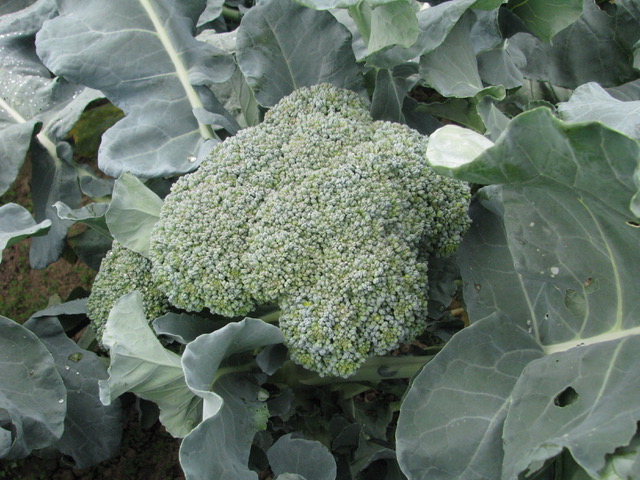
A crop like Broccoli can take four-six months to produce a king head (or main crown) from seeding. If planted in fall, they generally produce a head 6-8″ across in the greenhouse by late spring and meanwhile they use up to 4 square feet (2′ x 2′) of growing space per plant over the entire winter and some of the spring season. The broccoli shown here is Green Magic and even though suppliers say it is ready to harvest in 55-60 days, these numbers are misleading. In my experience, plants seeded late March, transplanted outside into the garden (with covers if needed in your area) in mid-late April, and grown on during the peak of summer light where days are longer than 12 hours, need four months of growing time (120 days) before harvest in July. When planted in a winter greenhouse it may take 6-8 months to grow the same plant to maturity from fall planting.
By November 5th the day length in my full sun south facing Calgary garden is shorter than ten hours and in my clients’ Vancouver garden, the day length is shorter than ten hours on November 1. To put this another way, a greenhouse seeded in late August only has two full growing months before plant growth really slows down; they might survive but they won’t thrive. If the greenhouse temperature is hovering at or above zero, these cold tolerant greenhouse plants do not die, but they largely stop growing. Unless extra heat and light is added, cool season crops will only grow again in a greenhouse by late February when days are longer.
“a greenhouse seeded in late August only has two full growing months before plants go into a holding pattern; they might survive but they won’t thrive”
Using the
Government’s Official Calculator of day lengths, today (November 30, 2023) I am getting 9.6 hours of sunlight a day in a perfectly open, sunny position with no shade from trees. On November 1, my client in Vancouver was getting 9.85 hours of light per day. And the days keep getting shorter until the first day of winter. As my dad used to say to me every December 22: “The days are getting longer now Donna!” Once growing slows down, harvests in your home greenhouse also slow down.
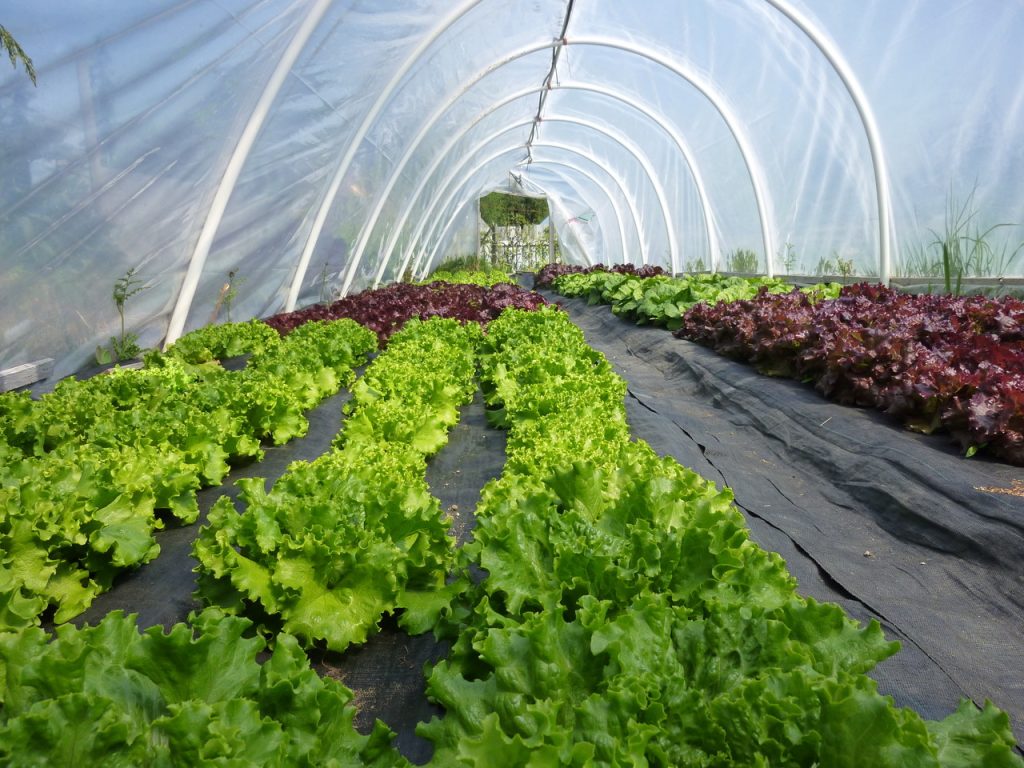
Fast growing hydroponic lettuce with warm nutrient packed water and long day length due to climate controls like lights and heat are produced on a 60 day cycle from seed to harvest. But the lettuce above, growing in cold soil in a commercial greenhouse, is only ready to harvest in the early spring days of mid-March after four months of growing. It takes so long, in fact, to grow lettuce with natural light and very little extra climate control, that if you plan to eat all you grow you will need a square foot for each cool season plant such as a head of lettuce for at least four months. If you plan to eat a head of lettuce a day from early to late March you have to dedicate an area 10′ x 3 feet – or half the ground growing area in an average 8′ x 10′ home greenhouse – all winter!
COOL GREENHOUSE PLANTS THAT THRIVE
My client wants to harvest food within two months of seeding and continue harvesting over the low-light winter days of October through January. To do this, she needs to choose super fast crops like leafy greens and put a lot of things in the greenhouse all at once, filling shelves on the walls, hanging plants from the roof and installing large planters on the ground. (PS I am offering a 10% discount to my clients who want to try growing a
Sproutbox Garden in their greenhouse this winter – using the discount Code DonnaB10 helps me help you.) With the head lettuce example described in the image above, it is easy to see how a gardener has to be creative when the size of their greenhouse is limited.
Mustard greens, kale, arugula, and spinach are examples of leafy green vegetables that tolerate cool greenhouse growing conditions and can be harvested a single leaf at a time rather than removing the whole head. If you add miniature
Bok Choi or head lettuce to the mix and remove them as individual whole plants, this leaves a gap for kale and spinach to keep growing all winter and fill in the space left between plants.
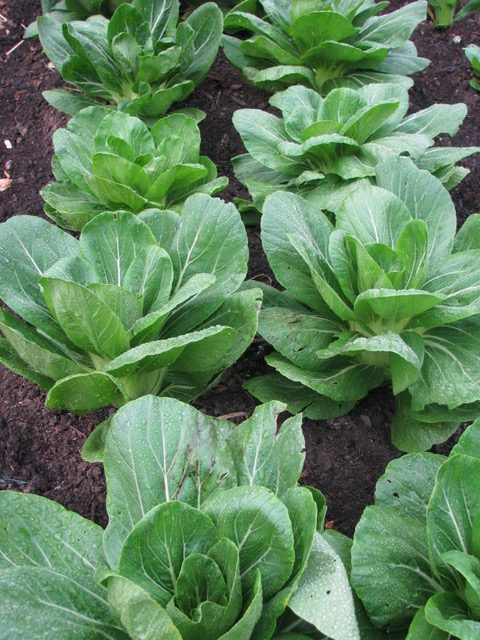
Bok choi grows well outside in a cool garden or in a winter greenhouse with climate controls. Harvesting a whole head at once for stir fry dinners and steamed green vegetables allows smaller leafy plants like kale or spinach growing in between the bok choi to expand to fill the space during late winter and early spring.
Sadly, really slow growing plants like cauliflower, or broccoli or Brussels sprouts may take 4-8 months to grow from seed to a harvestable size after seeding. And other cool crops like peas are hardy, but if you want pea pods, it will take a really long time for the plant to grow, mature, bloom and form peas. It is better to grow micro-green peas, which taste the same as pea pods in winter; micro-greens take days instead of months before harvests begin. Use space created through March harvests to start peas for pods and grow varieties like Oregon Giant up a trellis to use a third dimension when growing. ( this variety can be eaten as micro-greens, as flat Chinese pea pods or as fully puffed up edible podded peas.)
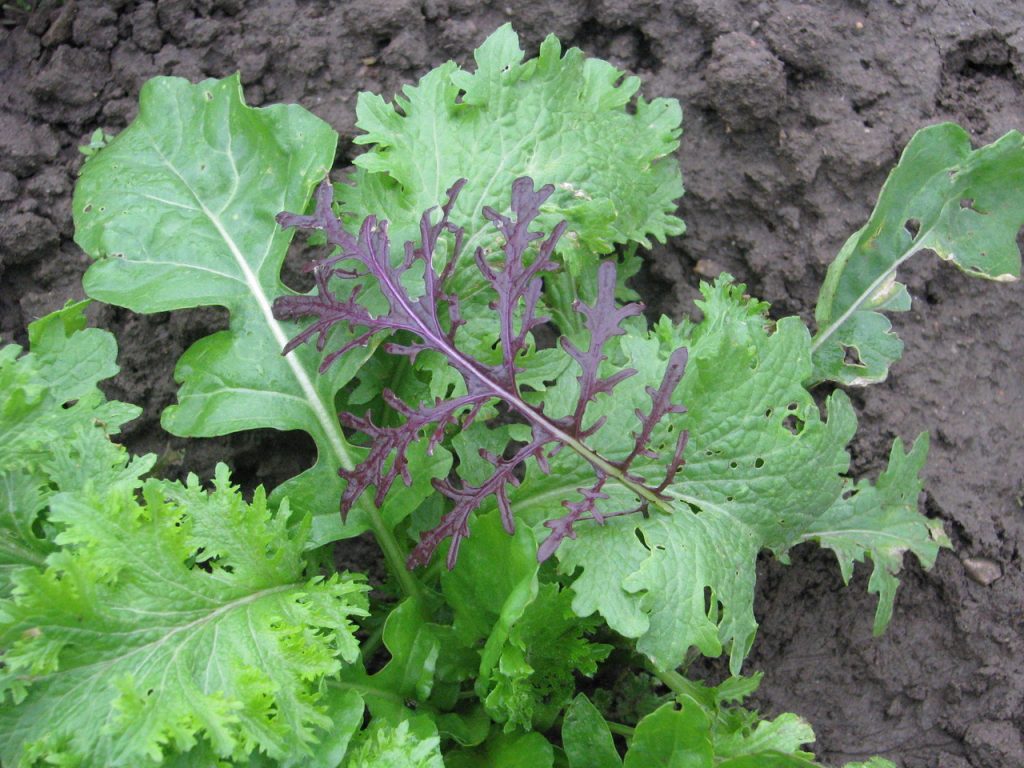
Mustard greens come in a variety of colours and shapes with narrow, broad or frilly leaves. They are harvested one leaf at a time so can be picked as needed.
GROW-LIGHTS BOOST GROWING
I ask my client to google her latitude and use her
Three Year Gardeners Gratitude journal to track when days are shorter than ten hours (approximately Oct- end of Feb) because unless she adds a lot more supplemental lights to boost the natural light during winter, she won’t get maximum plant growth in her home greenhouse.
Using supplemental lights and starting seeds indoors before planting seedlings out in your greenhouse also speeds up growth in the winter greenhouse. Cool crops such as arugula, kale, Bok Choi and spinach will germinate and grow in a mild indoor grow-light area and when moved out to the climate controlled greenhouse with extra lights, they can fill the gaps when lettuce and bok choi are harvested. Provided the greenhouse is heated to a minimum of 5 degrees C and florescent T5’s or LED grow-lights are hung no more than 30 cm above cool season crops, seedlings will keep growing in the greenhouse after transplanting.
Note that commercial growers use the big Halogen or Metal Halide lights but these are expensive energy hogs and they give off a lot of heat as well as light so are usually hung from the roof of commercial greenhouses above warm season crops such as cucumbers or tomatoes growing in the winter. Home greenhouse gardeners usually adopt LED’s or T5 lights because they are inexpensive to run and stay relatively cool even though they do need to be within 30 cm (12″) of the crop to be most effective. Regular overhead florescent lights, installed just below the roof of the greenhouse, will give the gardener enough light to move about in the greenhouse in the evening, but unlike metal halides, they will not give the struggling plants growing on the ground enough light to grow because they are simply too far away.
Greenhouse crops take time to mature, and unless you are simply eating the first small leaves of a crop in your greenhouse it will take six weeks of good light to grow a radish, four months to grow lettuce and five months to grow a cabbage in the winter. Crops like cauliflower, broccoli and Brussels sprouts will take 4-8 months to mature and produce the edible part of the plant (namely the broccoli head, the cauliflower head and the Brussels sprouts) when grown as a low-light winter crop. Extra lights and heat speeds up the timeline for growing somewhat but to be safe, pick a longer harvest date just in case the roof gets snow covered or there is an extended arctic blast of cold air outside.
“…in your cool fall and winter greenhouse it will take six weeks of good light to grow a radish, four months to grow lettuce and five months to grow a cabbage.”
AVOID OVER PLANTING: LARGE PLANTS NEED SPACE TO GROW
My client told me her husband used a whole packet of seed in each small rectangular container in his greenhouse. This means he over-planted his crop and when they all sprouted, they crowded and shaded each other and looked more like micro-greens than vegetables. This also means he wasted seed, and the extra seedlings need to be thinned, clipped off or transplanted to give room for the remaining plants to growth. A cauliflower, broccoli or Brussels sprout, for instance, easily takes up 4 square feet for each plant or a single plant per very large pot while a head lettuce takes a single square foot. I suggested clipping off and eating most of the extra seedlings to give the survivors space and time to mature.
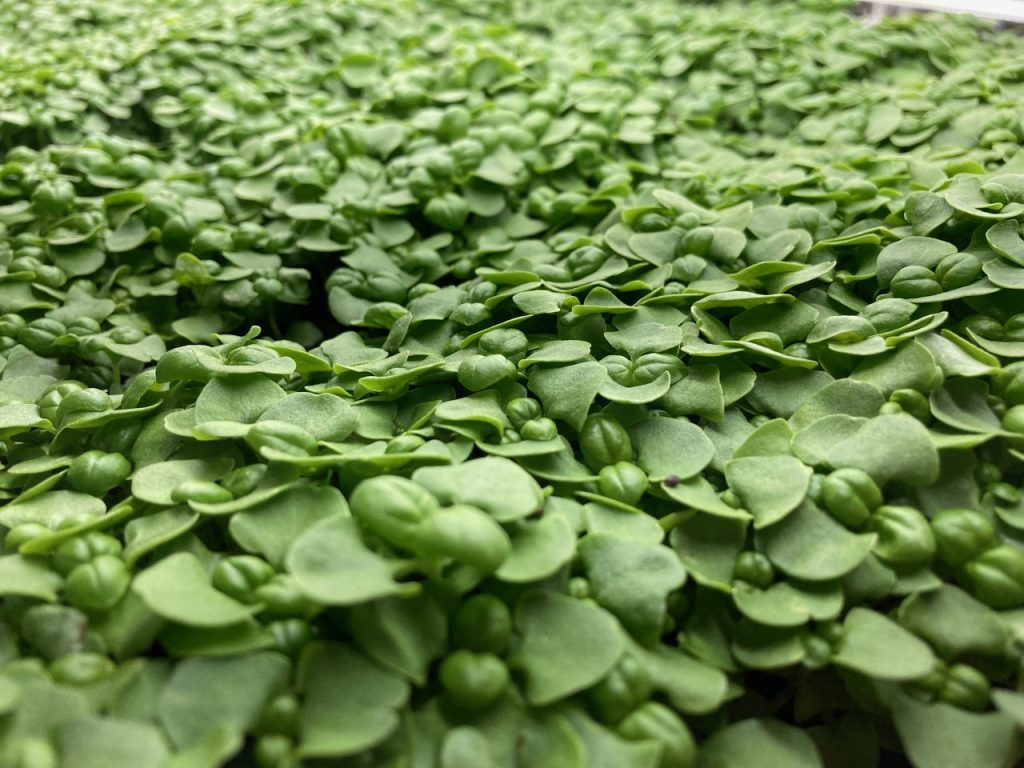
Basil is am amazing micro-green for adding flavour to dinners but it is a warm season crop best grown indoors under lights or in summer. Even when grown to an edible size, basil is kept on a counter in the kitchen to gradually harvest by clipping with scissors because Basil is so temperature sensitive it doesn’t even tolerate being in a fridge.
If micro-greens are the desired crop, stick to cool tolerant crops in winter like peas, kale, cilantro, mustard greens, arugula and collards instead of warm season crops like beans, basil and sunflowers because, in the winter, the cool crops will grow better in a home greenhouse. Growing several rotating trays of smaller micro-greens is a valid option and a nutritious treat as well but consider growing micro-greens indoors under lights and save greenhouse space for your longer season, larger plants. If a seeding mistake was made, thin out or clip off extra plants with scissors to avoid damaging roots of plants left in place. Also, take advantage of the wall space and head space in a greenhouse so you are using all the available room and not just the floor or the walls to grow greenhouse plants.

Pea greens or pea micro-greens are a cool season crop suited to either growing under lights in the home or in a cool greenhouse where they will grow slower. Remember peas are one of the few micro-greens that can be grown as a cut and come again plant as long as the lowest leaf is retained when harvesting the plants. I had one client tell me she harvested her little crop of micro-green peas for two months.
SOIL FERTILITY AND FERTILIZERS AFFECT PLANT GROWTH
Healthy green radish and beet leaves with no actual red roots below the soil level are a sign there is too much nitrogen available compared to phosphorus. If radish are seeded into a rich compost and the greenhouse is heated to at least 10-12 degrees C with overhead lights, the leaves will grow quickly because there will be a lot of nitrogen available to the growing plants. But when a balanced fertilizer is applied on top of seedlings where the nitrogen levels are already high, the plants become too bushy and the leaves too vigorous. Root crops like beets and radish will fail to form a root in these high nitrogen situations. So, be careful with fertilizer and compost when growing root crops. Use a spartan soil (with little or no compost) and incorporate a high phosphorus fertilizer into the soil before seeding.

Mind your additions of fertilizers when growing in a greenhouse and remember compost is usually a good source of nitrogen but probably a low source of phosphorus. Image by Mariko Paterson, illustrator of NO GUFF VEGETABLE GARDENING
Too much nitrogen and not enough phosphorus means healthy green leaves but poor root development. A potting mix without extra compost will work best for root crops. Adding a slow-release brand of fertilizer with a higher middle number before seeding is ideal for root development. When greens look amazing it means there is plenty of nitrogen. This is not a good thing for root crops. Instead, use a product like either
Biofert Superfos or Fish Bonemeal slow release organic fertilizer with a high middle number and lower nitrogen to push roots without pushing leafy growth.
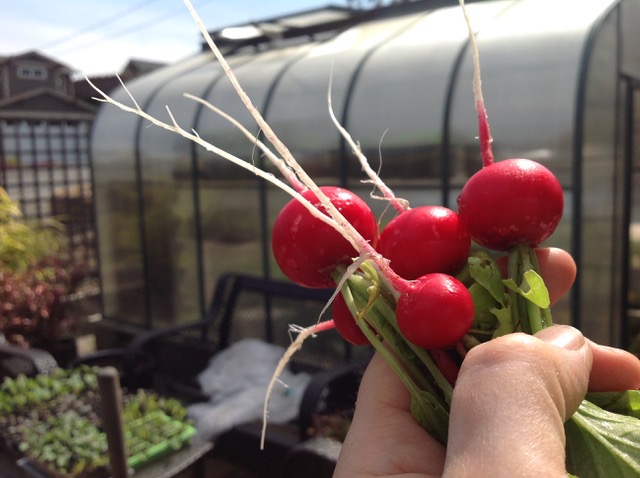
Lovely roots on my greenhouse-grown radish are ready in a month when grown in my cool spring Cross Country Greenhouse but will not form if the soil is too high in nitrogen or too low in phosphorus.
USE ALL THE SPACE AVAILABLE IN THE GREENHOUSE
Using all the space in a greenhouse is about more than adding a shelf to your greenhouse. It is also about air space. Many gardeners make use of all their growing space by using hanging baskets at various heights in their greenhouse as well as adding rows of shelves to the greenhouse walls. On the ground, large planters or pots of taller vegetables like really large kale or arugula can be planted to fill up the space in the middle zone of the greenhouse.
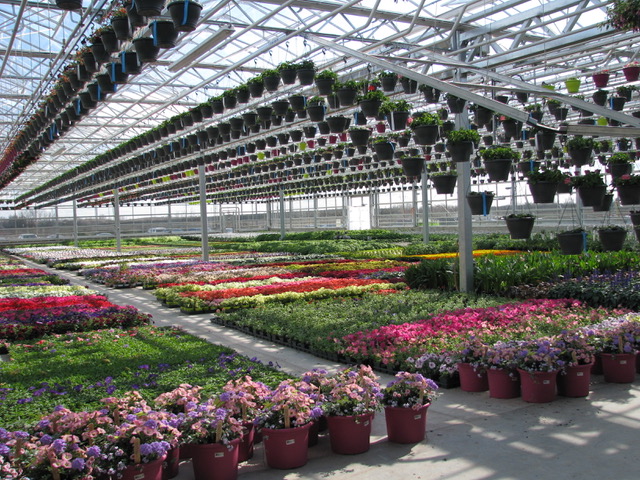
A commercial greenhouse takes advantage of the ground and the air space above the crops growing on the ground.
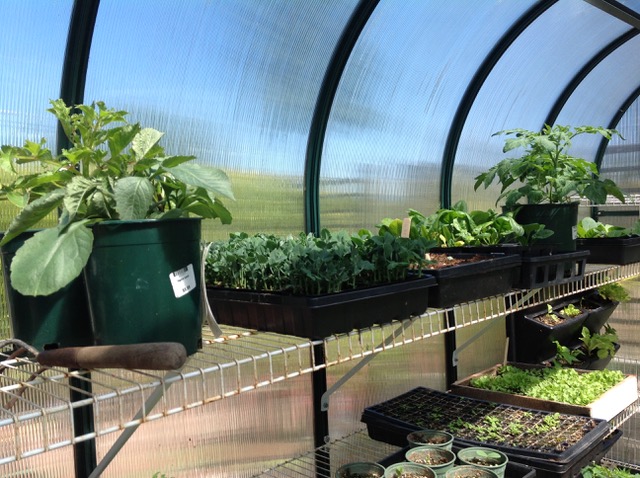
My Cross Country Greenhouse has shelves to hold seedlings and small plants not yet ready to plant in the ground. I also have hanging plants, rain gutters filled with seasonal strawberries and pots with larger lemon trees to make use of all the space available inside the greenhouse.
TENDER (WARM) CROPS VERSUS HARDY CROPS
It is possible to grow interesting food like cold tolerant strawberries in spring or lemons year round in a hobby greenhouse heated minimally just to stop soil from freezing. Greens are good but greens with fresh lemon sprinkled on top are even better!

Meyer lemons are grown in pots in my greenhouse where the temperatures may drop below freezing in winter. The lemon trees are in pots so they can be moved outside in summer, continue to grow and produce more fruit every year. To take my masterclass about growing potted lemons in cold climates with me and Steven Biggs Follow THIS LINK.
The average gardener dreams of growing tomatoes in their home greenhouse but tomatoes are warm crops – they need even heat and warm soil to grow from a small plant into a blooming sandwich-stuffing giant tomato with amazing taste. Other warm crops that will gradually replace cool crops in the spring and summer greenhouse include cucumbers, okra, basil and eggplant. I also like to grow a spring crop of zucchini because that way I can harvest small fruits and flowers at least a month before the outdoor plants are ready to eat. I pull the plants in the greenhouse out once the outdoor plants are producing zucchini because I don’t want to drown in these quick growing fruits, just extend my season a bit! Once the zucchini is removed, I have an opening to start fall crops earlier!
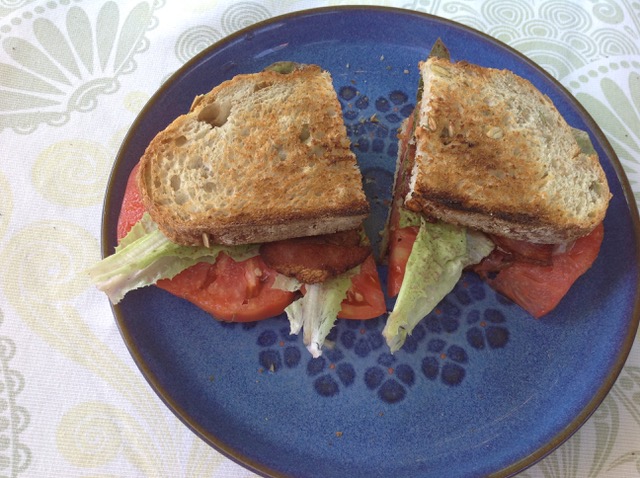
Tomatoes – too big for your toast – excite gardeners everywhere. But these are warm season crops better left to summer and fall growing and preferably in their own pots so they can be removed when they are no longer thriving without damaging young cool-season crops already brought in to replace them.
Another cold crop that loves a head start is strawberry. It tolerates cool winter weather but bursts into bloom when your greenhouse warms up in the spring, giving a month or two head-start compared to outdoor strawberries.
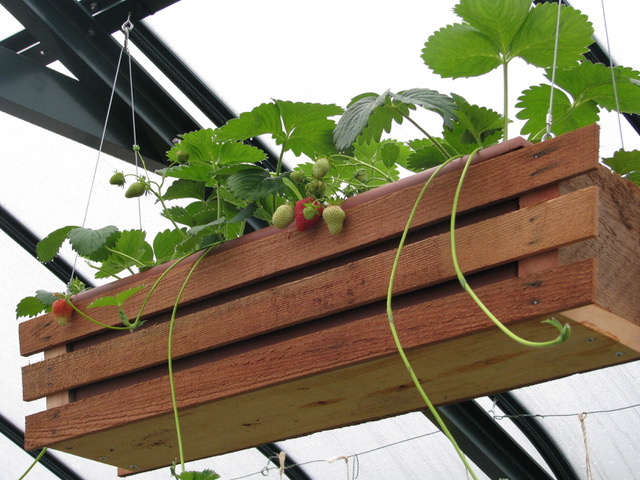
Hanging baskets of strawberries allow you to push the spring season ahead without taking up space on the greenhouse floor and this also means the last of your winter spinach will be enjoyed in a salad with the first of your fresh strawberries.
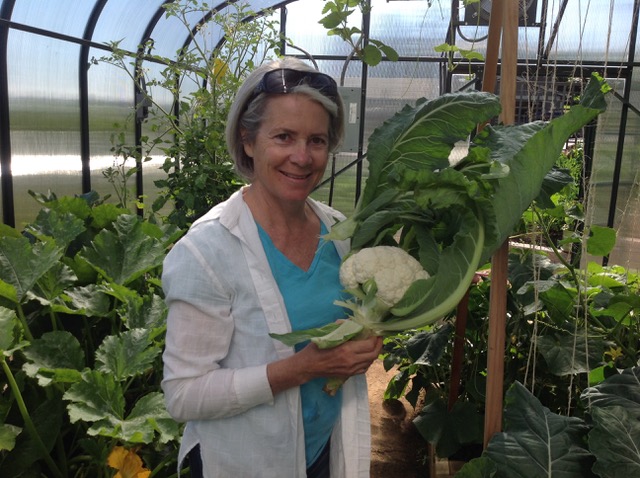
A cauliflower, especially the variety Galleon, is an overwintering cool crop in a greenhouse that literally takes months from seeding to harvesting fantastic heads in April. The only drawback to this and other large cold crops is that they take up so much valuable growing space for such a long time.
EXPAND YOUR KNOWLEDGE OF GROWING IN A GREENHOUSE
Another recent article quoting me about Getting Your Greenhouse Ready for winter is POSTED
RIGHT HERE.
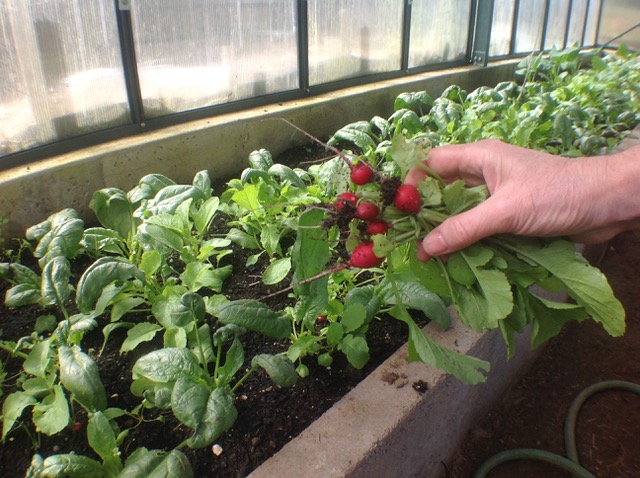
A winter greenhouse filled with radish, spinach and lettuce is a joy.
UNDERSTAND HOW DIFFERENT PLANTS GROW
Some plants like arugula, kale and spinach grow their leaves singly and can be harvested on leaf at a time any time you want to. These cold season plants are well suited to ongoing harvests in climate controlled greenhouses and the more you plant, the more you harvest all winter long.

Fresh salads are the delight of winter greenhouse growing.
Waiting for flowers and fruits is another story. If you want to grow cold season plants like peas or slow winter crops like cauliflowers there will be a lot of waiting and space wasted as the plants take time to mature. I knew a gardener who grew cauliflowers in her greenhouse all winter instead of anything else and then pulled them all out a couple of weeks before they made heads in April because she thought it was hopeless. Coincidentally, I grew the same plants the same year and a week after she pulled hers out mine started making large fabulous heads. They seemed to come from no-where. I wasn’t smug about it but I was sad for the other gardener who gave up a couple of weeks too soon.
If you want to grow tomatoes or other warm season crops like Basil or squash, there is no place in the winter garden even with tons of management. Cold soils and damp cool air are death to warm-season crops because they will suffer from root rot or leaf diseases when conditions are damp and cool. Better to wait and grow warm greenhouse crops in warm weather.
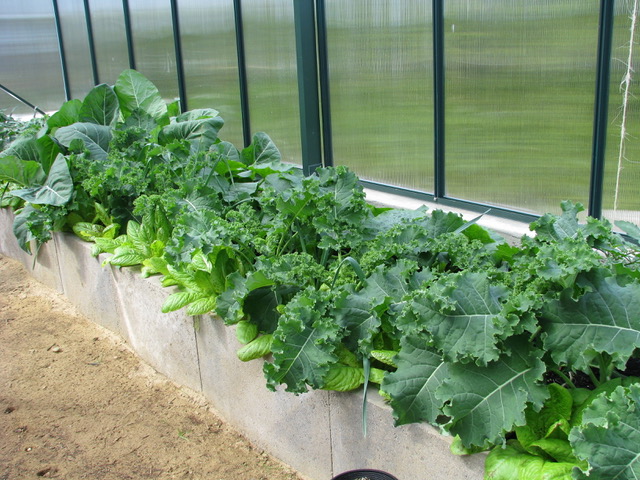
Late winter greenhouse is full of edible greens.
MANAGE EXPECTATIONS IN YOUR GREENHOUSE TO GET THE BEST HARVEST POSSIBLE
Managing expectations starts with assessing your situation. If you can’t provide extra light or warmth for cool tolerant plants in your greenhouse it doesn’t mean they will not grow. They will just grow very very slowly. You can cover them with heat-holding fabric like Agribon50 or you can lay heating cables on the soil surface under the young plants and the heat will stay under the row covers. Agribon does block additional light from reaching plants, though, so the length of time it takes to grow plants will be stretched out longer.
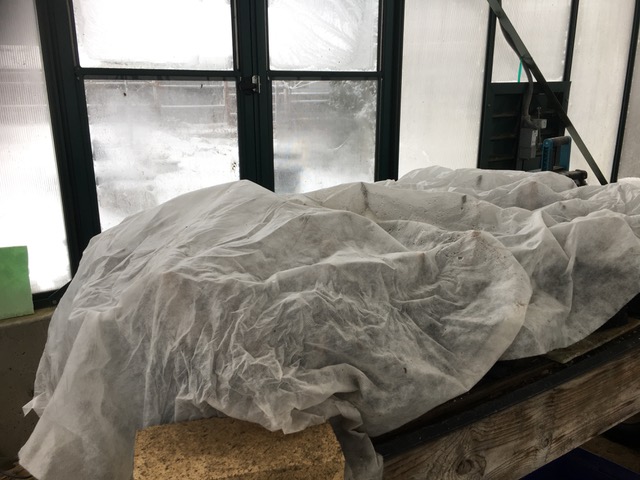
Row covers keep what little heat you have inside the greenhouse.
Changing fertilizers to suit the crops you want to grow, adding extra lights on a timer to extend light intensity or length or putting a circulating fan in the greenhouse will also move air around and keep plants disease free.
The best you can hope for when you start growing winter vegetables in your greenhouse is to savour the sweet taste of a freshly harvested spinach leaf on your tongue like i did last week. Then, over time, you can hope for huge crops of spinach all winter long. And in between, manage your expectations and start keeping track of everything you do on a daily basis so when something goes well, a quick review of your notes will help you going forward.
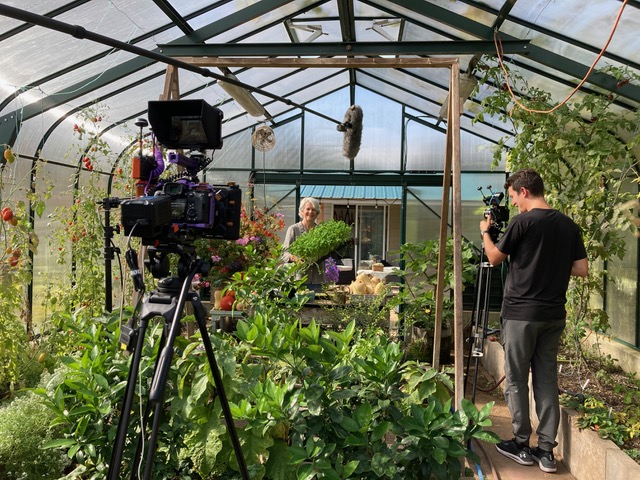
Filming a special video in my greenhouse for the Caesarstone Coast to Coast program last summer shows the bounty of crops to pick late in the season. But things do not look this full or green in winter! Check out the video filmed in my greenhouse on YouTube RIGHT HERE and note my segment starts at Minute 7.25 so you can fast forward to start right away!






